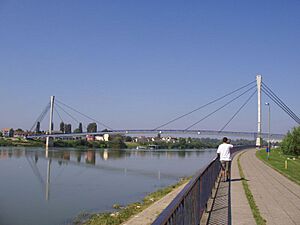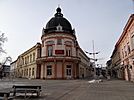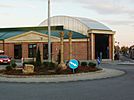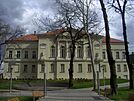Sremska Mitrovica facts for kids
Quick facts for kids
Sremska Mitrovica
Сремска Митровица (Serbian)
|
|||
|---|---|---|---|
| City of Sremska Mitrovica | |||
|
From top: Panorama of the city, Town library, Imperial Palace in Sirmium, Military- border building, Town Gallery, Building of the Police Station, The "Stone flower" fountain
|
|||
|
|||

Location of the administrative area of Sremska Mitrovica within Serbia
|
|||
| Country | |||
| Province | |||
| Region | Syrmia | ||
| District | Srem | ||
| Municipality | Sremska Mitrovica | ||
| Settlements | 26 | ||
| Area | |||
| • Urban | 49.62 km2 (19.16 sq mi) | ||
| • Administrative | 762 km2 (294 sq mi) | ||
| Elevation | 82 m (269 ft) | ||
| Population
(2022 census)
|
|||
| • Rank | 17th in Serbia | ||
| • Urban | 40,144 | ||
| • Urban density | 809.03/km2 (2,095.37/sq mi) | ||
| • Administrative | 72,580 | ||
| • Administrative density | 95.25/km2 (246.69/sq mi) | ||
| Time zone | UTC+1 (CET) | ||
| • Summer (DST) | UTC+2 (CEST) | ||
| Postal code |
22 000
|
||
| Area code | +381(0)22 | ||
| Car plates | SM | ||
Sremska Mitrovica is a city in Serbia. It is located on the left bank of the Sava River. In 2022, about 40,144 people lived in the city itself. The wider area around the city had a population of 72,580.
This city has a very old history. It was once known as Sirmium and was even a capital city of the Roman Empire in the 4th century CE. Did you know that ten Roman emperors were born in or near this city? Some of them include Decius Traian, Aurelian, and Maximian.
Contents
City Name: Sremska Mitrovica
The city's modern name is Sremska Mitrovica. In Hungarian, it was called Szávaszentdemeter. In Croatian, people call it Srijemska Mitrovica.
The name "Mitrovica" comes from Saint Demetrius, or "Sveti Dimitrije" in Serbian. "Sremska Mitrovica" means "Mitrovica of Syrmia". This helps tell it apart from Kosovska Mitrovica.
When it was part of the Roman Empire, the city was known as Sirmium. Around 1180 AD, its name changed. It went from "Civitas Sancti Demetrii" to "Dmitrovica", then "Mitrovica", and finally to its current name, "Sremska Mitrovica".
A Look Back: History of Sremska Mitrovica
Ancient Sirmium: A Roman Capital

Sremska Mitrovica is one of the oldest cities in Europe. Scientists have found signs of people living here as far back as 5000 BC. Even Ionian jewelry from 500 BC was found! When the Romans arrived in the 1st century BC, Sirmium was already a well-established place.
In the 1st century, Sirmium became a Roman colony. This meant it was a very important military and strategic spot in the Pannonia province. Roman emperors like Trajan, Marcus Aurelius, and Claudius II planned their war trips from Sirmium.
In 103 AD, Pannonia was divided into two parts. Sirmium became the capital of the southern part, called Pannonia Inferior. Later, in 296 AD, Emperor Diocletian divided Pannonia even more. Sirmium became the capital of a new province called Pannonia Secunda.
In 293 AD, the Roman Empire was split into four parts, a system called the tetrarchy. Sirmium became one of these four capital cities. The other capitals were Trier, Milan, and Izmit. During this time, Sirmium was the capital for Emperor Galerius.
From the 4th century, Sirmium became an important Christian center. It was home to a bishop. Four important Christian meetings, called councils, were held here. By the end of the 4th century, the Goths took over Sirmium. Later, it became part of the Eastern Roman Empire again.
In 441 AD, the Huns conquered Sirmium. After that, different Germanic tribes, like the Gepids, controlled it for over a hundred years. For a short time, Sirmium was the main city of the Gepid State. Their king, Cunimund, even made gold coins there. After 567 AD, Sirmium returned to the Eastern Roman Empire. However, the city was taken and destroyed by the Avars in 582 AD. This event marked the end of Sirmium's ancient history.
Archaeologists found 11 beautiful golden belts made by the Avars from the 6th century near the city.
From the Middle Ages to Modern Times
For the next two hundred years, Sirmium was not as important. In the late 8th century, it became part of the Frankish State. Its importance grew again in the 9th century when it was part of the First Bulgarian Empire. St Methodius was even given the title of Archbishop of Sirmium by the Pope.
In the 11th century, Sirmium was home to Sermon, a duke of Syrmia. He was a ruler under the Bulgarian king Samuil. After 1018, the city was again part of the Byzantine Empire. From the late 11th century, the Byzantine Empire and the Kingdom of Hungary often fought over Sirmium. Finally, in 1180, the Byzantines gave Sirmium to Hungary.
Around 1451, the Serbian ruler Đurađ Branković briefly owned the city. In 1521, the city was taken by the Ottomans. It stayed under Ottoman rule for almost 200 years. During this time, it was called "Dimitrofça". By the mid-16th century, most people living in the city were Muslims. In 1573, the city had 17 mosques but no Christian churches. Sremska Mitrovica was the biggest town in Syrmia during Ottoman rule. It was the main administrative center for the Ottoman region of Syrmia.
Austrian troops briefly took the city between 1688 and 1690. They finally took it for good in 1717. They officially gained control after the Treaty of Passarowitz in 1718. When the Habsburgs took over in 1718, many Muslim residents left. New settlers, including Serbian, Croatian, and German people, moved in.
Sremska Mitrovica was part of the Habsburg Military Frontier. This was a special border region. In 1848–49, it was part of the Serbian Vojvodina, a Serbian self-governing area. But in 1849, it went back to the Military Frontier. When the Military Frontier was ended in 1881, Sremska Mitrovica became part of Syrmia County. This county was part of the Kingdom of Croatia-Slavonia within Austria-Hungary.
In 1910, the city had 12,909 people. Most spoke Serbo-Croatian, and some spoke German.
Sremska Mitrovica After World War I
In 1918, the Austro-Hungarian Empire ended. The Syrmia region first joined the new State of Slovenes, Croats and Serbs. Then, on November 24, 1918, a meeting in Ruma decided that most of Syrmia, including Mitrovica, would join the Kingdom of Serbia.
Soon after, on December 1, 1918, the Kingdom of Serbia joined with other states to form the Kingdom of Serbs, Croats and Slovenes. This country was later renamed Yugoslavia in 1929. Sremska Mitrovica was part of different regions within Yugoslavia over the years.

During World War II, the city was taken over by Axis forces. It became part of the Independent State of Croatia. Its name was even changed to Hrvatska Mitrovica. During this difficult time, a concentration camp existed in Sremska Mitrovica. Many people, including Serbs, Jews, and anti-fascists, suffered there. Jewish people from Serbia were also affected by these events.
Later, during the Yugoslav wars, some prisoners of war from Croatia were held in the city's prison.
From 1944, the city became part of the Autonomous Province of Vojvodina. This was within the new Socialist Yugoslavia. From 1945, it was part of the Socialist Republic of Serbia. From 1992 to 2003, it was part of the Federal Republic of Yugoslavia. This then became the state union of Serbia and Montenegro. Since Montenegro became independent in 2006, Sremska Mitrovica is part of an independent Serbia.
Towns and Villages in Sremska Mitrovica
The city of Sremska Mitrovica includes the town of Mačvanska Mitrovica. It also has several villages.
Villages on the north side of the Sava river, in the Syrmia region:
- Bešenovački Prnjavor
- Bešenovo
- Bosut
- Čalma
- Divoš
- Grgurevci
- Jarak
- Kuzmin
- Laćarak
- Ležimir
- Manđelos
- Martinci
- Sremska Rača
- Stara Bingula
- Šašinci
- Šišatovac
- Šuljam
- Veliki Radinci
Villages on the south side of the Sava river, in the Mačva region:
- Noćaj
- Radenković
- Ravnje
- Salaš Noćajski
- Zasavica I
- Zasavica II
People of Sremska Mitrovica
According to the 2011 census, the Sremska Mitrovica area has 79,940 people.
Ethnic Groups
Most of the villages in the city area have a majority of ethnic Serbs. Stara Bingula is a mixed village with more Serbs than other groups. Most ethnic minorities live in the city itself.
Here's a breakdown of the ethnic groups in the city area from 2011:
| Ethnic group | Population 2011 |
% |
|---|---|---|
| Serbs | 69,849 | 87.38% |
| Croats | 2,112 | 2.64% |
| Romani | 1,194 | 1.49% |
| Hungarians | 696 | 0.87% |
| Rusyns | 620 | 0.78% |
| Ukrainians | 534 | 0.67% |
| Yugoslavs | 290 | 0.36% |
| Slovaks | 281 | 0.35% |
| Montenegrins | 131 | 0.16% |
| Macedonians | 126 | 0.16% |
| Germans | 103 | 0.13% |
| Others | 4,004 | 5.01% |
| Total | 79,940 |
Religion
Most people in Sremska Mitrovica are Orthodox Christians. They belong to the Eparchy of Syrmia of the Serbian Orthodox Church. There are also many Roman Catholics, who belong to the Diocese of Syrmia. This diocese has its main church in Sremska Mitrovica. There are also smaller groups of Protestants and Muslims.
Climate in Sremska Mitrovica
Sremska Mitrovica has a climate that is mostly humid subtropical. This means it has warm, humid summers and mild winters. It's also very close to a humid continental climate.
| Climate data for Sremska Mitrovica (1991–2020, extremes 1961–2020) | |||||||||||||
|---|---|---|---|---|---|---|---|---|---|---|---|---|---|
| Month | Jan | Feb | Mar | Apr | May | Jun | Jul | Aug | Sep | Oct | Nov | Dec | Year |
| Record high °C (°F) | 18.8 (65.8) |
23.7 (74.7) |
28.9 (84.0) |
31.6 (88.9) |
34.8 (94.6) |
36.8 (98.2) |
40.7 (105.3) |
39.6 (103.3) |
37.6 (99.7) |
30.2 (86.4) |
25.0 (77.0) |
22.0 (71.6) |
40.7 (105.3) |
| Mean daily maximum °C (°F) | 4.2 (39.6) |
7.3 (45.1) |
13.2 (55.8) |
18.8 (65.8) |
23.4 (74.1) |
27.0 (80.6) |
29.0 (84.2) |
29.3 (84.7) |
24.1 (75.4) |
18.6 (65.5) |
11.5 (52.7) |
5.0 (41.0) |
17.6 (63.7) |
| Daily mean °C (°F) | 0.6 (33.1) |
2.3 (36.1) |
6.9 (44.4) |
12.3 (54.1) |
17.3 (63.1) |
20.7 (69.3) |
22.1 (71.8) |
21.9 (71.4) |
16.9 (62.4) |
11.9 (53.4) |
6.8 (44.2) |
1.6 (34.9) |
11.8 (53.2) |
| Mean daily minimum °C (°F) | −2.7 (27.1) |
−1.9 (28.6) |
1.5 (34.7) |
6.1 (43.0) |
11.1 (52.0) |
14.3 (57.7) |
15.4 (59.7) |
15.3 (59.5) |
11.1 (52.0) |
6.9 (44.4) |
3.0 (37.4) |
−1.3 (29.7) |
6.6 (43.9) |
| Record low °C (°F) | −29.5 (−21.1) |
−26.5 (−15.7) |
−17.3 (0.9) |
−7.8 (18.0) |
−0.3 (31.5) |
3.0 (37.4) |
6.4 (43.5) |
5.8 (42.4) |
−2.0 (28.4) |
−6.0 (21.2) |
−13.5 (7.7) |
−21.3 (−6.3) |
−29.5 (−21.1) |
| Average precipitation mm (inches) | 38.1 (1.50) |
34.6 (1.36) |
37.6 (1.48) |
44.8 (1.76) |
68.1 (2.68) |
75.4 (2.97) |
59.7 (2.35) |
50.9 (2.00) |
56.6 (2.23) |
56.8 (2.24) |
48.8 (1.92) |
45.7 (1.80) |
617.1 (24.30) |
| Average precipitation days (≥ 0.1 mm) | 12.8 | 11.4 | 10.8 | 11.3 | 13.2 | 11.4 | 9.5 | 7.9 | 9.8 | 10.1 | 11.2 | 12.5 | 131.9 |
| Average snowy days | 6.8 | 5.7 | 2.8 | 0.4 | 0.0 | 0.0 | 0.0 | 0.0 | 0.0 | 0.1 | 2.1 | 5.1 | 23.0 |
| Average relative humidity (%) | 87.8 | 81.7 | 72.5 | 68.2 | 69.0 | 71.4 | 70.7 | 69.8 | 74.3 | 78.5 | 84.5 | 88.7 | 76.4 |
| Mean monthly sunshine hours | 63.6 | 95.1 | 159.2 | 197.5 | 245.2 | 262.0 | 297.0 | 288.0 | 198.5 | 156.2 | 90.5 | 53.2 | 2,106 |
| Source: Republic Hydrometeorological Service of Serbia | |||||||||||||
Economy and Jobs

In 2018, about 20,298 people had registered jobs in Sremska Mitrovica. The table below shows how many people work in different types of jobs:
| Activity | Total |
|---|---|
| Agriculture, forestry and fishing | 645 |
| Mining and quarrying | 16 |
| Manufacturing | 5,402 |
| Electricity, gas, steam and air conditioning supply | 233 |
| Water supply; sewerage, waste management and remediation activities | 342 |
| Construction | 958 |
| Wholesale and retail trade, repair of motor vehicles and motorcycles | 2,887 |
| Transportation and storage | 1,080 |
| Accommodation and food services | 447 |
| Information and communication | 167 |
| Financial and insurance activities | 334 |
| Real estate activities | 35 |
| Professional, scientific and technical activities | 749 |
| Administrative and support service activities | 486 |
| Public administration and defense; compulsory social security | 1,610 |
| Education | 1,339 |
| Human health and social work activities | 1,820 |
| Arts, entertainment and recreation | 318 |
| Other service activities | 332 |
| Individual agricultural workers | 1,098 |
| Total | 20,298 |
Sports Clubs
Sremska Mitrovica is home to several sports clubs:
- KAF Sirmium Legionaries: This is an American Football club. It was the first American Football club in Serbia.
- FK Srem: A football (soccer) club from the city.
- FK Radnički Sremska Mitrovica: Another football (soccer) club.
- KK Val: A canoe club for water sports.
Famous People from Sremska Mitrovica
Roman Emperors Born Here
Ten Roman emperors were born in or near Sremska Mitrovica (Sirmium):
- Decius Traian (249–51)
- Herennius Etruscus (251)
- Hostilian (251)
- Claudius II (268-270)
- Quintillus (270)
- Aurelian (270–75)
- Probus (276–82)
- Maximianus Herculius (285–310)
- Constantius II (337–61)
- Gratian (367–83)
The last emperor of the united Roman Empire, Theodosius I (378–95), became emperor in Sirmium. Other Roman emperors also spent time in Sirmium, including Marcus Aurelius. He might have written parts of his famous book Meditations here.
Other Notable Residents
Many other important people have connections to Sremska Mitrovica:
- Mira Banjac: A famous Serbian actress.
- Branislav Ivanović: A well-known Serbian football player.
- Mileva Marić: A Serbian scientist.
- Veljko Petrović: A Serbian poet.
- Ilarion Ruvarac: A Serbian churchman and historian.
City Partnerships
Sremska Mitrovica has special partnerships with other cities around the world. These are called "twin towns" or "sister cities".
 Banja Luka, Bosnia-Herzegovina
Banja Luka, Bosnia-Herzegovina Dunaújváros, Hungary
Dunaújváros, Hungary
See also
 In Spanish: Sremska Mitrovica para niños
In Spanish: Sremska Mitrovica para niños

















